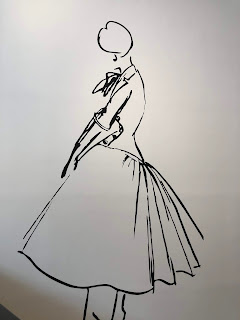A few weeks ago I went to the Christian Dior Exhibition, 'Designer of Dreams' at the Victoria and Albert Museum.
I thoroughly enjoy visiting exhibitions and felt it was worth going to see. I had previously been to the McQueen exhibition at the V&A and was looking forward to seeing if this would rival it. I'm very pleased that I booked tickets so early as they've now all sold out!
The exhibition takes you through key events, elements and silhouettes from the House's 72 year history, opening with the iconic 'New Look' from 1947 and was surrounded by other white and black ensembles by Gianfranco Ferre, John Galliano and Maria Grazia Chiuri.
Other rooms allowed you to get close to the garments, instead of them being presented behind glass so the true craftsmanship and detail of the pieces could be viewed clearly. I was particularly impressed with how well preserved the garments were. I have attended other exhibitions where sadly, the clothing is damaged or has not been well looked after but this was definitely not the case here. The beading and embroidery on the pieces was immaculate and the fabrics showed no staining and decay. Also, the vividness of the colour of the vintage pieces gave the impression that they could have been made yesterday.
 |
 |
The surrounding installations aid the mood of the exhibition by changing in atmosphere, style, colour and sound throughout the various themes that are explored in the exhibition. Drawings, photographs, miniature garments and videos accompany the exhibits, providing additional context, but my particular favourite installation was 'Les Invasions Paper Garden' by Wanda Barcelona. Paper flowers adorned the ceiling and parts of the walls, implying a delicate and natural mood that matched the floral garments on display.
One of my other favourite rooms was the toile room. A show stopping collection of the couture sample toiles (which are all made in white) around each wall of the room. Once again, you could see how they were made and all the changes that had occurred during the making process. I think this is really important to see when discussing or showing the design process; its ok to make and document the mistakes as it will make the outcome better.
Other displays featured key pieces by the House's creative directors through history. John Galliano's work is incredibly strong in these areas as his pieces are by far the most dramatic. However, the clean lines of Raf Simon's pieces, and the simplicity and femininity of Maria Grazia Chiuri's work is also presented beautifully in open spaces that allow you a detailed look at how they were made.
Overall, its a great exhibition and worth the money. The V&A is releasing a few limited tickets for this exhibition on the 15th of each month and there are a limited number available each day directly from the V&A, so if you want to see it, act quick!























































